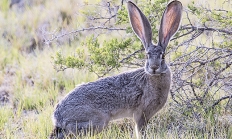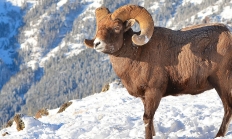
Search myodfw.com


The black-tailed jackrabbit is slightly smaller than the white-tailed jackrabbit but considerably larger than the snowshoe hare. In conformation, it is much like the white-tailed jackrabbit. West of the Cascade Range, the dorsal hairs of this rabbit have gray blending to dark-brown or blackish base followed by a narrow band of buff and a black tip. Hairs on the throat, sides, and rump have gray bases blending to buff with short black tips. On the venter, hairs are white with light pinkish-buff tips. The tail is black on the dorsum and dark buff on the venter. The ears are dark

A box calls is the most popular turkey call, and is a good choice for new turkey hunters. Box calls not only are easy to use, but they can sound very realistic. A box call can create a wide range of yelps, clucks, purrs, fighting purrs, cackles and gobbles. If you can get yelps, clucks and purrs to sound good on a box call, you’ll routinely bring in birds. Parts of a box call Box calls come in two parts – a narrow rectangular box with a paddle attached at one end. Attached with a single screw in the center

Features: Rocky Mountain bighorn sheep are the largest-bodied bighorn in North America and one of two subspecies of wild sheep in Oregon. Bighorn sheep were extirpated from the state in the 1800s so current populations are the result of a reintroduction effort by ODFW and sportsman groups. Habitat: Oregon’s estimated 800 Rocky Mountain bighorn sheep are found in the northeast corner of the state, in canyons of the Snake River and its tributaries and in alpine areas of the Wallowa Mountains. Techniques: Bighorn sheep are one of the rarest game species hunted in Oregon today, with about 100 tags available


Updated August 18, 2025 Subscribe for updates Starting Jan. 1, 2026, an Ocean Endorsement is needed for most recreational anglers fishing in the ocean. Check the Ocean Endorsement page for more information. Ocean Endorsement
Features: California bighorn sheep are one of two subspecies of wild sheep in Oregon. They are usually smaller, with a less blocky build and smaller horns than Rocky Mountain bighorn sheep. Bighorn sheep were extirpated from the state in the 1800s. Current populations are the result of a reintroduction effort by ODFW and sportsman groups. Habitat: California bighorn sheep are the most abundant subspecies in Oregon with an estimated 3,700 found among 32 herds in central and southeast Oregon. They prefer rugged, open habitats with a good view of their surroundings. Techniques: Bighorn sheep are one of the rarest game


If this is a new activity for you, our friends at the Audubon Society have tips on how to start birding and how to connect with other birders. This is a great resource that also includes tips on choosing binoculars, reviews and recommendations on the best birding apps and field guides, and an easy seven-point guide on how to identify birds. The Cornell Lab of Ornithology has an extensive website that includes the world's largest archive of wildlife sounds and videos, bird cams, eBird citizen science opportunities, scientific publications, bird guides, bird nesting box plans and more.
Features: The mountain goat is stockily built with black scimitar-shaped horns, large black hooves and prominent dewclaws, and an entirely white, woolly coat. Habitat: Rocky Mountain goats are found in steep and rugged habitat in eastern Oregon, including the Wallowa, Elkhorn and Strawberry mountains, and the central Cascades near Mt Jefferson. Techniques: Rocky Mountain goat tags are “once-in-a-lifetime” and less than 25 are available each year. Be prepared to hunt their steep, rugged habitat if you are lucky enough to draw a tag.

Angling closed on the lowest reach of Eagle Creek in the Clackamas basin Sept. 27 through Oct. 31
CLACKAMAS, Ore. – Angling will be closed on the lowest reach of Eagle Creek in the Clackamas basin from Sept. 27 through Oct. 31 to give coho salmon a safe resting area amid ongoing low water flows. The closure is from SE Dowty Road downstream to the Clackamas River confluence. Similar to last year…

Some of Oregon's larger mammals, such as deer and elk can easily be seen at places like Jewell Meadows Wildlife Area, Dean Creek Elk Viewing Area, and the North Bank Habitat Management Area. Black-tailed deer are frequently seen in western Oregon along roadsides. Commonly seen animals include raccoons, rabbits, squirrels, and skunks. A quiet walk in the forest or desert, a keen eye and a good pair of binoculars will reward you with glimpses of some of our more secretive animals. Some viewing tips include: keep your distance, move as silently as possible or pick a spot and remain still
Townsend's chipmunk is the largest member of the genus in Oregon.The pelage of this chipmunk is dark and dull but as in other Oregon chipmunks, there is a dark brown to blackish middorsal stripe with alternate light and dark stripes, laterally, a total of five dark and four light stripes. Alternate dark (three) and light (two) stripes adorn the sides of the face. The throat, belly, and a patch behind the ear are white. The tail is black on the tip and the margins are frosted above with buff or white-tipped hairs. Townsend's chipmunks have been found on the west



Salmon hit more milestones in the Klamath River: Chinook reach areas above Upper Klamath Lake
Image: The circles show monitoring stations in the basin and the green shows detection of a tagged salmon. KLAMATH FALLS, Ore. — Salmon are making exciting progress in their return to the upper Klamath Basin, with fisheries biologists from ODFW and The Klamath Tribes celebrating a series of firsts…
